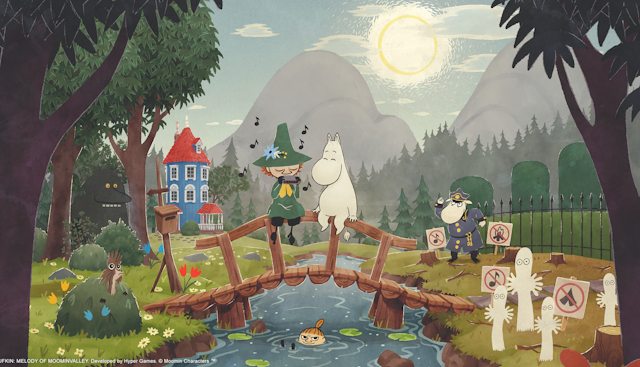Moomin author Tove Jansson’s work is characterised by a desire for balance: balance between the knowable and the unfamiliar; balance between sentiment and practicality. And balance between fragility (of people, things, mood and place) and resilience, displayed often by the smallest and the most frightened.
The Moomin books centre on the adventures of the Finn Family Moomintroll; round, white and large-snouted creatures descended from trolls, who live in Moominvalley with an extended group of family and friends of different species.
In the Moomin stories, moments of contentment and security are offset by what Jansson’s biographer Boel Westin describes as “the typical Moomin feeling for catastrophe”. Even in the drawing room of the Moominhouse where the family hibernate in the warmth of the quietly smouldering peat stove “the silence [is] deep and expectant”. Just outside is the Groke, the Lady of the Cold – and the lure of the Lonely Mountains.
Raw Fury, the developers of the new Moomin game Snufkin: Melody of Moominvalley have pitched it as a “cosy” adventure game. But they don’t always balance that cosiness with the catastrophic undertones that give the books their richness.
In Moominland Midwinter (1957), Moomintroll leaves his slumbering family and heads out to explore the snowy valley he only knows in its summer form. The movement from a safe starting point into an exploration of a new space, punctuated by encounters with new experiences and people is very similar to the plot of the game.
Snufkin (a philosophical, fishing vagabond character from Jansson’s books) sets out to restore his dry valley to its former glory. Many Moomin books focus on an episodic quest, often navigated within a mappable terrain. Comparably, one of the items in the game’s inventory is a lovely map of its world. It draws faithfully on Jansson’s own cartography of Moomin Valley.
But Moominland Midwinter is more than a snowy adventure. It is a coming-of-age story, a treatise on the perils of dwelling on the past, or on yourself, and an exploration of fear, tolerance and longing.
These are children’s stories, but within them Jansson explored humanity’s quirks and frailties. She told her own stories too. Comet in Moominland (1946), for example, is “a book written in the shadow of war”, and Jansson’s relationships are represented by characters such as Too-ticky (the Moomin version of her life partner, Tuulikki Pietilä).
Playing Snufkin: Melody of Moominvalley
I felt sceptical as I embarked on the opening game-play, navigating Snufkin’s annual return to the valley, which was alarmingly parched and barren.
I also felt sheer frustration at the gaming process – too much wandering around dead ends, too many rocks to be collected and dropped to enable the crossing of streams, so many nameless “creeps” to be lured by music and stacked on top of each other in order to ascend cliffs.
But once I had got into a quest to find Moomintroll, I found much to enjoy. I liked the simple delight of identifying familiar characters. It was satisfying seeing the way the game’s dried river bed echoed the changes in the natural world like snow, volcanoes and floods that generated stories in the Moominvalley books.

Snufkin: Melody of Moominvalley attempts to connect with Jansson’s books through its environmental focus. This permeates both the design and story of the game, and is an echo of Jansson’s own concerns for balance between nature and its inhabitants.
The trailer describes it as an “adventure game about restoring harmony with nature”. Progress is facilitated by defeating the park keeper’s attempts to turn the untamed natural beauty of Moominvalley into parks, with ordered paths and spaces and signs forbidding fun.
This echoes Moominsummer Madness (1954), when Snufkin rescues the little woodies (a group of lost children) from the park in which the keeper has “cut and sheared every single one of the trees into round blobs and square cubes, and [where] as soon as any leaf of grass dared come up it was cut off”.
Conversely, Snufkin finds his “inspiration” in the game by rustling through free-growing plants and shrubs. Power is found in a natural world that is not tampered with or controlled, just as in Jansson’s stories.
Snufkin: Melody of Moominvalley’s artwork
For me, the most striking element was the game’s art artwork. It is faithful to Jansson’s now iconic line drawings, and the colours used in her paintings.
Moomin artwork has arguably become a charming commodity – I own a vast collection of Moomin merch myself – disconnected from the complexities of Jansson’s stories.
In the books, however, the art is as much part of the story as the text and allows Jansson’s voice to avoid the pitfalls of translation. The black ink strokes do not need recreating in any other language. Her tiny details of expression – a furrowed brow, a downcast eye – is made clever use of in the game’s construction of character.

The game also claims to be “story rich”. But for those players who are familiar with the books, but less so the structure, pace and presentation of a video-game narrative, this is what seems to be lacking.
In transcribing her stories into something fundamentally visual and kinetic as opposed to linguistic, Jansson’s language is lost. The dialogue is often generic and repetitive, lacking in Jansson’s idiom much of the time, and a fundamental magic of the books is missing.
Snufkin: Melody of Moominvalley struggles to recreate the philosophy of the books, or to replicate the richness of characterisation and mood that Jansson generates through her storytelling. A platform game that requires you to stack small, unnamed, creatures on each other’s heads to progress to higher levels in your own journey, might not be the most apt way to tell a story about rediscovering nature’s lost balance.

Looking for something good? Cut through the noise with a carefully curated selection of the latest releases, live events and exhibitions, straight to your inbox every fortnight, on Fridays. Sign up here.

